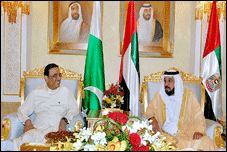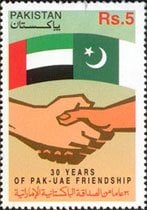Mehmood-Ul-Hassan Khan
United Arab Emirates is the prime example of marvelous socio-economic development in the world achieved in a very short span of time. It is one of the biggest socio-economic achievements of the United Arab Emirates that despite ongoing sever global economic recession and financial crunch, its macro economy maintained its sustainability and responded very well and increasing inflows of foreign investments and high levels of trade volumes verify it. Now, its economy has noticeable diversification, vibrancy and self-reliance. Non-oil trade has increased. Industrial production is continuously on the rise. Inflation is under control and the last but not the least consumer confidence is strong and stable which all indicate that new phase of economic development has been started.
The leaders of the UAE and Pakistan are committed for further strengthening of bilateral trade and commerce ties. In this regard, the 9th Pak-UAE Joint Ministerial Commission was held in 2007. Agreements on bilateral political consultations, establishment of Joint Business Council and protocols on cooperation in culture media were signed.
Visionary leadership of the United Arab Emirates, His Highness Sheikh Khalifa bin Zayed Al Nahyan the President, the Vice President and Prime Minister and Ruler of Dubai, His Highness Sheikh Mohammed bin Rashid Al Maktoum, and supported by the other members of the Federal Supreme Council play vey important role, due to which now the UAE is on the path of socio-economic glory.
Economic Development
Right from the beginning, the visionary leadership is keen to boost economic conditions of its people. They initiated many mega projects and effective policies and succeeded to achieve the desired goals. The UAE Government Strategy 2011-2013 and the UAE Vision 2021 are the two master piece policies of macro-economic development not confined only to social, cultural, health, schooling, infrastructure, communications, and rural development. Both major policies will deal the enhancement of collaboration between federal and local authorities, delivering high quality, consumers and customer satisfaction, good governance and human resource management.
The world economic crisis 2008 affected the Gulf economies and the UAE is not any exemption but immediate policy adjustments of its policy makers succeeded to lessen its multiplier economic ramifications. Now, the latest published reports of the IMF and WB verify its bright economic prospects and GDP may be in the range of 3.2 percent in 2010. Central Bank Governor Sultan bin Nasser Al Suwaidi projected GDP three to four per cent for the UAE in 2010.
(a) Foreign Direct Investments
UAE has become ideal country for foreign direct investments. UAE has attracted more than $73 billion in foreign direct investment (FDI) since 1971. Now it is the second top FDIs recipient in the region, according to UN statistics. Cumulative FDI flow into the UAE totaled around $73.4 billion, nearly 26 per cent of the combined foreign capital received by the six-nation Gulf Cooperation Council (GCC).
According to the data of SBP and BOI, the UAE is also one of the biggest investor in Pakistan. It was $228.6 million in 2008-2009 which reached to $248.6 million in the fiscal year 2009-2010. The portion of private sector needs to be revised and increased. Chambers of commerce of the two countries, Pak-UAE Business Council and person-to-person contact could be useful to boost further the trade volumes.
Period Amount US$ million
2005-06 1,424.5
2006-07 661.5
2007-08 589.2
2008-09 178.1
2009-2010 243.1
Source: SBP & BOI
Moreover, Energy, construction, telecommunication, oil & gas exploration, insurance, banking, aviation, food packaging, and hotels and agricultural would be preferred sectors of economy for seeking UAE FDIs in Pakistan. The Government of Pakistan has invited UAE’s public and private sectors to invest in energy sector, airline and infrastructure. Investments in agriculture, agro-based industries and hydro-power generation may also be beneficial to both the countries.
(b) Innovation-Driven Economy
According to the latest Global Competitiveness Report (2010) by the World Economic Forum, UAE has been included in the most advanced stage of “innovation-driven economies” in the world for the second consecutive year for its technological readiness along with others pillars of WEF. Moreover, UAE ranked “third” in “government provision of high technology products”. Again, according the latest report of the WEF (2010) UAE ranked “third” in the world for quality of infrastructure. UAE has biggest Airports, biggest Cargo Terminal, Tallest Buildings, and other wonders of the modern age. Moreover, the UAE has been ranked among the top 10 countries in more than 18 indicators of competitiveness globally, and has reached an advanced position among the 139 countries assessed by the WEF report.
Prosperous Country
According to the London-based Legatum Institute (September, 2010), the UAE is the top-ranking Middle Eastern country on the Prosperity Index by taking into account both economic growth and citizens’ quality of life.
(c) Second Largest Economy in the Region
According to Sultan Bin Saeed Al Mansouri, Minister of Economy, despite the UAE’s small size and population it has the second largest Arab economy in the region where the gross national product reached Dh914.4 billion in 2009 and is confidently expected to cross the one trillion dirham mark by the end of 2010.
(d) Diversification of Economy
The key macro-economic indicators of the UAE provide clear evidence of the success of its government’s policy of economic diversification. In 1971, 70 percent of GDP came from the oil and gas sector, but in 2009, despite much higher oil prices and much higher oil production, supplemented by gas production, this sector contributed only 29 per cent of GDP. According to Abu Dhabi Statistical Book (2010), non-oil exports totaled Dhs9.5bn, with key goods being plastics and basic metals, which constituted 65 percent of the total. Re-exports in 2009 were valued at Dhs8.7bn. The Ministry of Foreign Trade (September, 2010) revealed that the UAE has been the top global re-exporter of rice over the past 5 years (2005 – 2009).
Period Imports US$ million Change % Exports US$ million Change %
2005-06 3,405,563 19.83 1,312,757 99.96
2006-07 2,769,091 5.51 1,385,082 18.69
2007-08 3,413,527 49.52 2,070,953 23.27
2008-09 3,159,742 29.02 1,469,990 43.00
Source: SBP and BOI
In recent years, Pakistan has increased its non-non-traditional exports items up to 67 percent followed by 35 percent from textile manufacturers and four percent from other manufacturers. Petroleum, petrochemical products, iron ore, scrap-plastics, chemical products, non-ferrous metals-machines, spare parts of cars ships and boats. Nylon textiles, silk & wool, rice, cotton, crochet-dye, textile-treatment requirements are the important commodities of imports and exports between the two countries. Joint ventures in energy production especially in hydro-power and alternative energy projects would be productive for Pakistan. Cooperation in corporate agricultural farming, dairy farming and livestock, financial sector, housing would also be helpful for Pakistan.
Effective Monetary and Fiscal Policies
Thanks to the policies taken by the government such as guaranteeing bank deposits and pumping in Dh120 billion to support the banking sector, the United Arab Emirates’ national economy has proven its strength and competence in dealing with the repercussions of the economic crisis. Furthermore, the UAE ranked 20 at the WEF (2010), for the countries which have achieved the best financial development in 2009. Sultan bin Nasser Al Suwaidi, the governor of the Central Bank of the UAE, that its country’s banking industry is strong and stable. According the latest report of the central bank of the UAE (2010), the overall performance of its banking sector is positive, stable and sustainable. Standard & Poor’s believes that the UAE authorities have a strong incentive, as well as willingness and capacity, to preserve the stability of their banking sector. For its part, Moody’s said it was unlikely the proposed Dubai World debt restructuring scheme would have “negative rating implications” on UAE banks. Total deposits held by all UAE banks reached around Dh1 trillion for the first time in 2010.
UAE and Pakistan could extend their mutual cooperation in banking and especially in Islamic banking for the mutual benefits of both the countries.
Steady Progress in Millennium Development Goals (2015)
The leaders of the UAE have already initiated diversified but integrated policy measures to achieve its MDG (2015). All the positive indicators in education, health, housing and social welfare indicate that the UAE is rightly placed on the right path to achieve all the MGDS before 2015. They have introduced effective and people friendly policies to increase employment opportunities. They have adopted holistic strategies to provide every possible basic necessities of life to its people. They have relaxed its immigration policies for the benefits of many developing countries around the world.
Selected MGDs
MGDs indicators UAE Achievements
Universal Primary Education The net enrolment rates for grades 1-5 is 98 percent in 2005, which suggests 100% target ratio is achievable by 2015. The literate rate of 15-24 years is 98.55 percent in 2004. The number of government schools has increased from 1256 in the 2007-2008 to 1350 in the 2008-2009 with the number of students increasing from over 600,000 to more than 700,000. The number of accredited universities and institutes, both government and private, having reached 64.
Reduce Child Mortality In 2006, there were 33 government hospitals in the country. In 2009, the number had increased to 40. There are 115 primary health care centres, 67 health centres and 11 primary school health centres in the UAE. It is ranked No. 1 in the Gulf region by providing all possible health care facilities, medication to its people.
Ensure Environmental Sustainability It has already initiated effective policy measures to protect the environmental sustainability
Women Empowerment According to the recent report of the World Economic Forum (September 2010) on gender gaps the UAE has gained first position in the region and has moved up nine places in gender equality.
Concluding Remarks
Keeping in view the latest reports of International Monetary Agency, World Bank, Global Competitiveness Report (2010) by the World Economic Forum and many others internationally reputed credit agancies, it is crystal clear that macro-economy of the UAE is strong, stable and sustainable. Its society is articulated and educated and enjoys with all the possible facilities of education, health, housing and law and order. Its culture is dynamic with full of life which combines traditions with modernity. It has become hub of foreign direct investments, trade, service sector and tourism. It is hoped that successful implementation of Government Strategy 2011-2013 and the UAE Vision 2021 would bring all the desired results in the days to come.


Assurance that Pakistan assist with economic protection. There is no scare from Iran besides America.
Seeking control the area to eventually. Invade Iran if this possible since. There protected by Russia historical nations, yeah wrote: prior. Gulf States, Oman,Saudi Arabia and Algeria. Need non western power efficient in technology this why. Employment excellent living in Ummah. Shall this eventually help
fellow Pakistanis yes. New Administration could retain power by using. Appropriate investments for these
vidle sources of influence. Reverse the need see were ready for warfare. Gulf states afraid of elements of
foreign invasion. EU and United Kingdom decline to assist them. So need as Iran-Iraq problems 20yrs.
Prior they seeking Pakistan along Central Asia. Brothers prize as Nawaz promise allow middle class.
When the anti captialist continue bomb can this. Cease yes, by guard force as Russia and Libya. Allow
a Islamic nation on Tunisia or UAE I dislike. Egypt model why the demi leader affect. Regarding President for life yes current leader in power! 1981 along Ben Ali Tunisia 1987 I forgotten. First brother
Qaddafi 1969 as your reading all friends of prominent political. Parties of Pakistan that is Nawaz long before Benzair whom.Gotten into last only problem shall military allow.The dream of liberal Pakistan?
UAE going assist with transportation light rails. Lahore and Karachi and expand port faclities. Ish Allah!